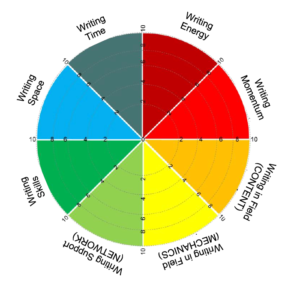Maybe you’ve heard us say “may your writing be brief, frequent, low stress, and highly rewarding.” Have you ever wondered where that comes from?
In Write No Matter What: Advice for Academics, Dr. Joli Jensen, founder of the Henneke Faculty Writing Program at the University of Tulsa, reminds us that the “key to scholarly writing pleasure” comes from regular, low stakes (i.e., low stress) and engaging sessions with our research and scholarly writing projects. Jensen points out that writers who procrastinate and binge in long stretches often find writing stressful and tend to avoid writing to the degree their projects may stall.
Such stalls are talked about openly and honestly at CSU Writes and are the subject of the upcoming GRAD Writes workshop: “Overcoming Writing Stall to Build Momentum,” April 6, 2-2:50. In this and other workshops, we recognize the necessity of working through challenging periods of getting pen to paper.
Most writers will face blocks in their work. As individuals, we each face our own unique challenges—perhaps even routinely so. To identify and address these individual needs, we devised Wheel of Writing Life. The wheel helps writers quickly identify their writing
As individuals, we each face our own unique challenges—perhaps even routinely so. To identify and address these individual needs, we devised Wheel of Writing Life. The wheel helps writers quickly identify their writing strengths and weaknesses so that they can see what may be stalling them and to then target specific professional development and approaches to support “brief, frequent, low stress, and highly rewarding encounters” with their projects.

We use the wheel in the workshop as an awareness-raising exercise. To counter the common problem of the writing block, we must first understand what unique hurdles we face as writers. Once those are identified, we can work on problem solving to the specific problem—or problems—you face as a writer.
In the workshop we will also discuss Jensen’s techniques to overcome writing stalls. Jensen’s three “taming techniques” serve as practical and effective writing strategies for any writer. These techniques include 1) write for at least fifteen minutes, six days a week, 2) use a project box to contain writing, and 3) vent challenges in a ventilation file.
The project box is a literal box that contains documents and resources related to a specific writing project. By using the box to dictate when you write, you can literally put the project away by closing the box when you are done working for the day.
The ventilation file can take several different forms. Perhaps you include a journal or notebook in you project box, or maybe you have a Word document for this purpose, but the ventilation file is a place for you to write about the project, your progress, your process, or the things keeping you from finding and building momentum.
Aligned with the wheel’s categories, CSU Writes addresses the four primary areas research writers struggle most: space, time, energy/momentum, and style. We do this practically through workshops, retreats, guest speakers, show up & write., and peer editing groups.
To learn more about the Writing Life Wheel, habits to build and sustain writing momentum, and how to redirect our inner writing critics, consider attending our workshops and retreats for FACULTY Writes, GRAD Writes, and our special events.
